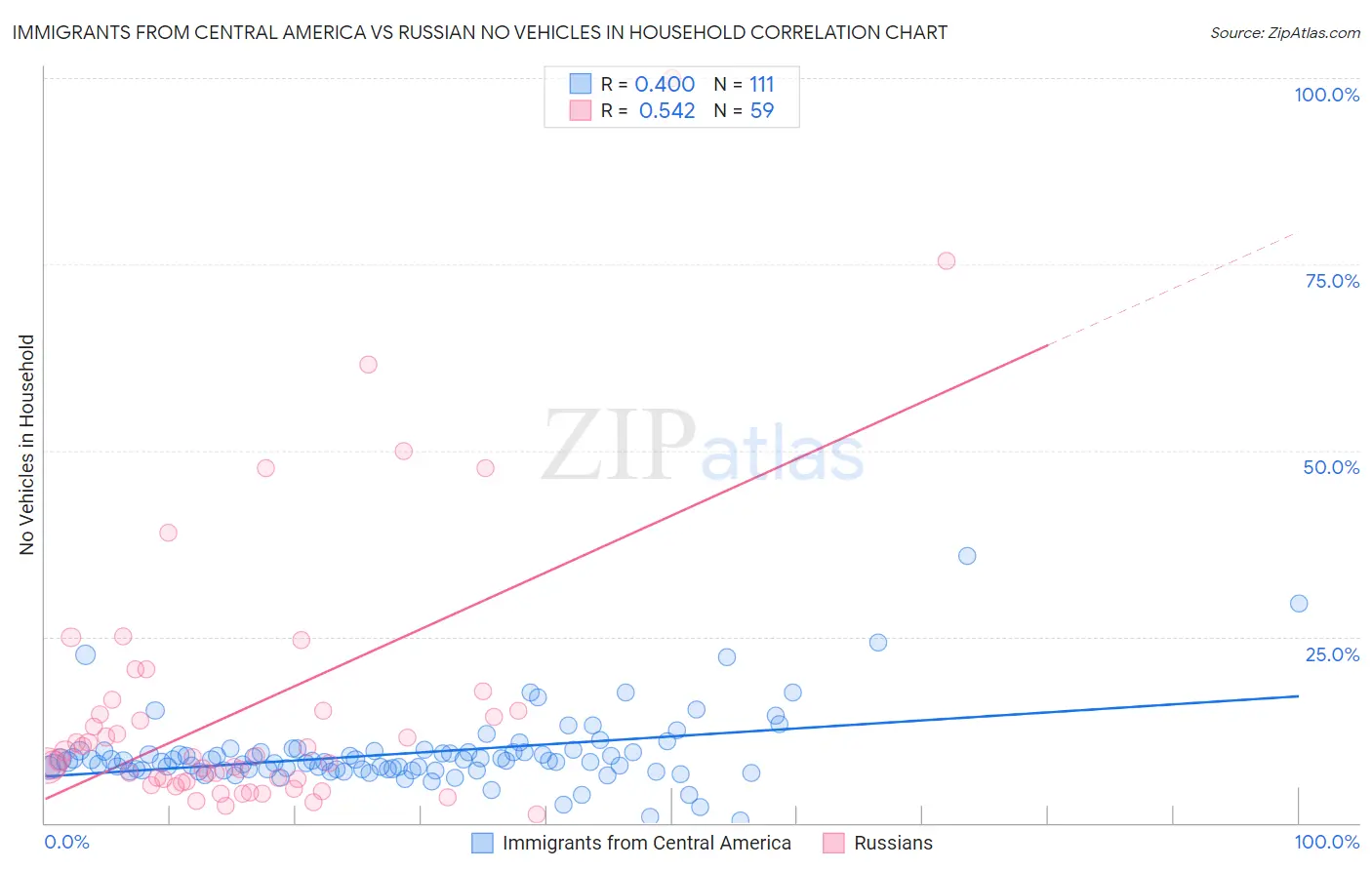Immigrants from Central America vs Russian No Vehicles in Household
COMPARE
Immigrants from Central America
Russian
No Vehicles in Household
No Vehicles in Household Comparison
Immigrants from Central America
Russians
8.9%
NO VEHICLES IN HOUSEHOLD
98.5/ 100
METRIC RATING
97th/ 347
METRIC RANK
11.6%
NO VEHICLES IN HOUSEHOLD
3.2/ 100
METRIC RATING
238th/ 347
METRIC RANK
Immigrants from Central America vs Russian No Vehicles in Household Correlation Chart
The statistical analysis conducted on geographies consisting of 533,101,389 people shows a moderate positive correlation between the proportion of Immigrants from Central America and percentage of households with no vehicle available in the United States with a correlation coefficient (R) of 0.400 and weighted average of 8.9%. Similarly, the statistical analysis conducted on geographies consisting of 509,184,789 people shows a substantial positive correlation between the proportion of Russians and percentage of households with no vehicle available in the United States with a correlation coefficient (R) of 0.542 and weighted average of 11.6%, a difference of 30.0%.

No Vehicles in Household Correlation Summary
| Measurement | Immigrants from Central America | Russian |
| Minimum | 0.36% | 1.2% |
| Maximum | 35.8% | 100.0% |
| Range | 35.5% | 98.8% |
| Mean | 9.3% | 15.6% |
| Median | 8.3% | 8.8% |
| Interquartile 25% (IQ1) | 7.1% | 5.6% |
| Interquartile 75% (IQ3) | 9.6% | 15.0% |
| Interquartile Range (IQR) | 2.5% | 9.4% |
| Standard Deviation (Sample) | 4.9% | 18.7% |
| Standard Deviation (Population) | 4.9% | 18.6% |
Similar Demographics by No Vehicles in Household
Demographics Similar to Immigrants from Central America by No Vehicles in Household
In terms of no vehicles in household, the demographic groups most similar to Immigrants from Central America are Slavic (9.0%, a difference of 0.31%), Bulgarian (9.0%, a difference of 0.36%), Asian (9.0%, a difference of 0.55%), Pakistani (9.0%, a difference of 0.59%), and Yugoslavian (9.0%, a difference of 0.63%).
| Demographics | Rating | Rank | No Vehicles in Household |
| Bhutanese | 99.2 /100 | #90 | Exceptional 8.7% |
| Immigrants | Germany | 99.1 /100 | #91 | Exceptional 8.7% |
| Immigrants | Canada | 99.1 /100 | #92 | Exceptional 8.7% |
| Immigrants | North America | 99.1 /100 | #93 | Exceptional 8.7% |
| Austrians | 98.9 /100 | #94 | Exceptional 8.8% |
| Potawatomi | 98.8 /100 | #95 | Exceptional 8.8% |
| Immigrants | Bolivia | 98.7 /100 | #96 | Exceptional 8.9% |
| Immigrants | Central America | 98.5 /100 | #97 | Exceptional 8.9% |
| Slavs | 98.4 /100 | #98 | Exceptional 9.0% |
| Bulgarians | 98.4 /100 | #99 | Exceptional 9.0% |
| Asians | 98.3 /100 | #100 | Exceptional 9.0% |
| Pakistanis | 98.3 /100 | #101 | Exceptional 9.0% |
| Yugoslavians | 98.3 /100 | #102 | Exceptional 9.0% |
| Seminole | 98.3 /100 | #103 | Exceptional 9.0% |
| Zimbabweans | 98.0 /100 | #104 | Exceptional 9.0% |
Demographics Similar to Russians by No Vehicles in Household
In terms of no vehicles in household, the demographic groups most similar to Russians are Ute (11.6%, a difference of 0.050%), Cree (11.6%, a difference of 0.29%), Taiwanese (11.7%, a difference of 0.46%), Immigrants (11.7%, a difference of 0.52%), and Eastern European (11.7%, a difference of 0.53%).
| Demographics | Rating | Rank | No Vehicles in Household |
| Immigrants | Japan | 5.1 /100 | #231 | Tragic 11.4% |
| Immigrants | Turkey | 4.8 /100 | #232 | Tragic 11.5% |
| Houma | 4.7 /100 | #233 | Tragic 11.5% |
| Immigrants | Peru | 4.5 /100 | #234 | Tragic 11.5% |
| Kiowa | 4.0 /100 | #235 | Tragic 11.5% |
| Cree | 3.5 /100 | #236 | Tragic 11.6% |
| Ute | 3.3 /100 | #237 | Tragic 11.6% |
| Russians | 3.2 /100 | #238 | Tragic 11.6% |
| Taiwanese | 2.8 /100 | #239 | Tragic 11.7% |
| Immigrants | Immigrants | 2.7 /100 | #240 | Tragic 11.7% |
| Eastern Europeans | 2.7 /100 | #241 | Tragic 11.7% |
| Turks | 2.6 /100 | #242 | Tragic 11.7% |
| Cheyenne | 2.4 /100 | #243 | Tragic 11.7% |
| Immigrants | Portugal | 2.2 /100 | #244 | Tragic 11.7% |
| Immigrants | Honduras | 2.1 /100 | #245 | Tragic 11.8% |